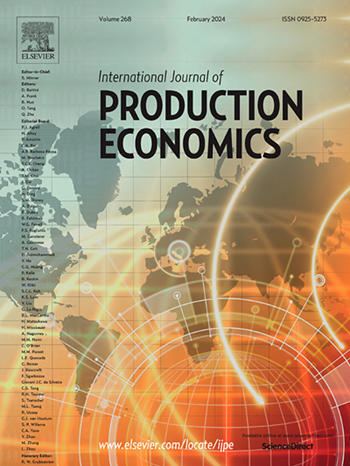智能生产和光催化紫外线(PUV)废水处理对纺织供应链管理的影响
IF 9.8
1区 工程技术
Q1 ENGINEERING, INDUSTRIAL
引用次数: 0
摘要
纺织供应链管理中服装生产系统的废水是水污染的主要来源之一。由于传统的废水处理方法效果不佳,特别是在去除污染的有机颗粒和重金属方面,废水仍然是大中型生产企业面临的一个日益严重的问题。光催化紫外法是近十年来发展起来的一种具有有机颗粒去除效果的环保废水处理方法。本研究考察了纺织供应链管理,该供应链使用光催化紫外工艺处理生产系统的废水。生产系统对废水的排除起着重要的作用。不必要的生产时间不仅会产生多余的服装,还会产生多余的废水,这些废水与染料提取物混合在一起。智能生产能够根据需要控制服装生产,并且可以控制废水的产生。尽管废水量很大,但废水处理逐渐成为纺织供应链中具有经济价值的一部分。纺织供应链管理是由多供应商、多制造商构建的,其中服装生产由智能生产系统控制。厂家提供光催化紫外线废水处理,这种废水处理对服装的市场需求产生了积极的影响。本研究的全局最优方案证明,智能生产的使用使纺织供应链成本降低18.55%,PUV废水处理成本降低16.01%。研究结果表明,在纺织供应链管理中,使用分类劳动力进行物料处理比使用未分类劳动力更具成本效益。技术劳动力是纺织供应链管理中最敏感的群体。本文章由计算机程序翻译,如有差异,请以英文原文为准。
Smart production and photocatalytic ultraviolet (PUV) wastewater treatment effect on a textile supply chain management
Wastewater from a garment production system in a textile supply chain management is one of the main sources of water pollution. Wastewater is still an increasing problem for medium to large production industries as traditional wastewater treatments are not much effective, especially for removal of contaminated organic particles and heavy metals. Photocatalytic ultraviolet process is an eco-friendly and promising wastewater treatment since the last one decade with the removal of organic particles. This study examines a textile supply chain management, which uses the photocatalytic ultraviolet process for the wastewater treatment from the production system. The production system plays an important part to exclude wastewater from the system. The unnecessary production run-time not only produces excess garments but also produces excess wastewater, which is blended with dyestuff extracts. A smart production is able to control the garment production based on the necessity and the control of wastewater generation is possible. Despite of the amount of wastewater, the treatment of wastewater gradually becomes a part of the textile supply chain with economic valuation. The textile supply chain management is built by multi-supplier and multi-manufacture, where the garment production is controlled by a smart production system. The manufacturers provide a photocatalytic ultraviolet wastewater treatment and this wastewater treatment positively effects the market demand of garments. The global optimum solutions of the study prove that the use of smart production reduces the cost of the textile supply chain 18.55% followed by the PUV wastewater treatment 16.01%. The results reveal that an involvement of categorized labor for material handling in a textile supply chain management is cost effective rather than using uncategorized labor. Skilled labors are found to be the most sensitive for a textile supply chain management.
求助全文
通过发布文献求助,成功后即可免费获取论文全文。
去求助
来源期刊
CiteScore
21.40
自引率
7.50%
发文量
266
审稿时长
52 days
期刊介绍:
The International Journal of Production Economics focuses on the interface between engineering and management. It covers all aspects of manufacturing and process industries, as well as production in general. The journal is interdisciplinary, considering activities throughout the product life cycle and material flow cycle. It aims to disseminate knowledge for improving industrial practice and strengthening the theoretical base for decision making. The journal serves as a forum for exchanging ideas and presenting new developments in theory and application, combining academic standards with practical value for industrial applications.

 求助内容:
求助内容: 应助结果提醒方式:
应助结果提醒方式:


